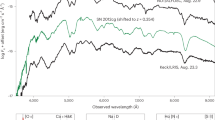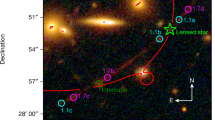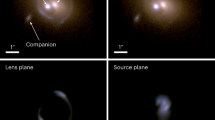Abstract
We report here observations which confirm Paczynski's speculation1 that the previously known2 pair of 19th magnitude quasars 1146 + 111B,C are actually two images of a single object produced by a gravitational lens. The image splitting is 157 arc s, more than 20 times greater than any previously reported3, thus indicating an exceptionally massive lensing object. The data supporting the lens hypothesis are remarkably similar, high signal-to-noise, moderate-resolution spectra of the two components. Both spectra show strong Mg II λ2,798 emission at z = 1.012±0.001 with indistinguishable redshifts (Δv = 126±309 km s−1), widths (FWHM = 64±4 Å) and detailed profile shapes. Both spectra also show broad troughs at λ6,180 and several weaker continuum features. Neither object exhibits the [O II] λ3,727 line which is frequently strong in Mg II emission objects. If the foreground galaxy clustering apparent in a deep R band charge-coupled device (CCD) image proves insufficient to explain the large image splitting, other possibilities such as massive dark objects (for example, a ∼1015 M⊙ black hole) or a cosmic string may be indicated.
This is a preview of subscription content, access via your institution
Access options
Subscribe to this journal
Receive 51 print issues and online access
$199.00 per year
only $3.90 per issue
Buy this article
- Purchase on Springer Link
- Instant access to full article PDF
Prices may be subject to local taxes which are calculated during checkout
Similar content being viewed by others
References
Paczynski, B. Nature 319, 567–568 (1986).
Arp, H. & Hazard, C. Astrophys. J. 240, 726–736 (1980).
Turner, E. L. IAU Symp. No. 117, 209–218 (1986).
Hazard, C., Arp, H. & Morton, D. C. Nature 282, 271–272 (1979).
Vilenkin, A. Astrophys. J. Lett. 282, L51–L53 (1984).
Gott, J. R. Astrophys. J. 288, 422–427 (1985).
DeVeney, J. An Observer's Manual for the Cryogenic Camera (Kitt Peak National Observatory, Tucson, 1985).
Young, P., Gunn, J. E., Kristian, J., Oke, J. B. & Westphal, J. A. Astrophys. J. 241, 507–520 (1980).
Lawrence, C. R. et al. Science 223, 46–49 (1984).
Paczynski, B. Astrophys. J. 301, 503–516 (1986).
Schneider, D. P., Gunn, J. E. & Hoessel, J. G. Astrophys. J. 264, 337–355 (1983).
Mushotzky, R. F., Serlemitsos, P. J., Smith, B. W., Boldt, E. A. & Holt, S. S. Astrophys. J. 225, 21–39 (1978).
Author information
Authors and Affiliations
Rights and permissions
About this article
Cite this article
Turner, E., Schneider, D., Burke, B. et al. An apparent gravitational lens with an image separation of 2.6 arc min. Nature 321, 142–144 (1986). https://doi.org/10.1038/321142a0
Received:
Accepted:
Issue Date:
DOI: https://doi.org/10.1038/321142a0
This article is cited by
-
Space fabric wrinkles: history of observational searches for exotic structures in the Universe
La Rivista del Nuovo Cimento (2021)
-
Lensing by exotic objects
General Relativity and Gravitation (2010)
-
A small mass, large image separation gravitational lens model
Astrophysics and Space Science (1988)
-
Marginal gravitational lenses of large separation: probing superclusters
Nature (1987)
Comments
By submitting a comment you agree to abide by our Terms and Community Guidelines. If you find something abusive or that does not comply with our terms or guidelines please flag it as inappropriate.



